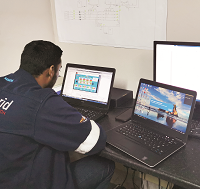

Hybrid Automation was approached by one of its clients, a leading South African FMCG company, to provide an automated solution for an existing plant in the factory. Being a popular confectionary manufacturer, the challenge faced with was to implement more control and monitoring functionality on one of its ovens, which was completely hard wired with all manual control.
The oven required plenty of operator intervention to run. Motors and burners had to be switched on and off manually. There was no interface to control the system or view alarms. If there were faults with electrical equipment or instruments, these were very difficult to fault find, which led to lengthy downtimes on the line, loss of production, and wastage.
The Hybrid Automation solution
The client requested that Hybrid Automation perform an upgrade on the system to automate the oven control. This would entail the control of four gas burners in four double tempering zones for a closed temperature control loop, as well as control of motors and safety monitoring.
The key beneficiaries of the upgrade were the production and maintenance teams. For the production team, it meant they would have a more productive oven with less downtime, and for the maintenance team, it meant that work would be more efficient.
For the biscuit manufacturer, the rewards achieved by the nature of this upgrade were prodigious. This upgrade would create much easier operation, a more automated and controlled system, and an easy to understand central operator interface panel where all operations and faults can be monitored.
The equipment specified in design for this project was as follows:
• A Siemens S7-1500 PLC used for the automation and control: this modular, scalable, and universally usable system is a preferred choice for many automated solutions as it delivers high performance with excellent usability.
• A Siemens TP1200 Comfort touch-screen HMI: the high performance and functionality of this HMI provided a perfect platform for operator control, alarming, trending and maintenance.
• Danfoss FC302 Profinet VSDs: these were used to control the motors as they were the recommended site standard for drives.
Implementation
The specified equipment along with motor protection, switchgear and other electrics were housed in a six-door electrical control panel built and supplied by Hybrid Automation. In addition to this Hybrid also provided field sensory devices and various electrical components. The existing gas burners however, were retained.
The system control was used to run a 40 metre steel oven belt through four double tempering zones for a defined time. This is the baking time for the product and determines the product to travel time from zone 1 to zone 4. The product is baked during the travel and exits onto an unloading conveyor that cools the baked product during transfer to the cream line where it gets creamed and packaged. The operator has full functionality to modify and select recipes, which contain baking times, zone temperatures, damper settings and motor speeds.
PID loops were used to control the temperatures in the four double tempering zones according to the recipes. K-type thermocouples were used to measure the temperature in the four zones and the burners were used to maintain the temperature under control of the PLC. Dampers control the air flow in all four zones.
Ongoing support is provided to the client in terms of improvements and system maintenance.
The success of this project was determined in terms of results required. It was rated a success as the system runs according to the functional specification, there is more control to the system, and all operations and faults can be monitored at the central HMI. The manufacturer now reaps the benefits of an automated oven control system, yet another achievement for Hybrid Automation.
| Tel: | +27 31 573 2795 |
| Email: | [email protected] |
| www: | www.hybridautomation.co.za |
| Articles: | More information and articles about Hybrid Automation |

© Technews Publishing (Pty) Ltd | All Rights Reserved